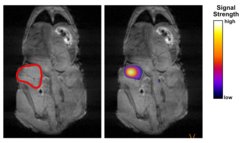Funding for a new method in cancer diagnostics
An efficient contrast agent method for MRI developed by Max Planck researcher Stefan Glöggler raises hopes of being able to distinguish tumors from healthy tissue on the basis of their metabolic activity. The ForTra gGmbH für Forschungstransfer of the Else Kröner-Fresenius Foundation (ForTra) and the European Research Council (ERC) are now providing funding to further develop the method for clinical patient studies.
Cancer cells consume vast amounts of energy: They grow and divide much faster and more frequently than healthy body cells, which results in greatly increased energy requirements. To meet this increased demand, they change how they metabolize sugar. Through a process known as lactic acid fermentation, cancer cells convert the molecular “fuel” glucose into the body’s own metabolite pyruvate and finally into lactic acid (lactate). In clinical MRI studies, scientists are already using pyruvate as a biomarker – a biological characteristic – to identify tumors. Tumor cells produce a significantly higher amount of lactic acid than healthy cells. Stefan Glöggler and his team are taking advantage of this feature for their MRI procedure.
“Using a special form of hydrogen during a chemical reaction we increase the nuclear spin signal of pyruvate by several thousand times. This signal amplification allows us to specifically observe the conversion of pyruvate into lactate – this way, we can use pyruvate as a contrast agent,” explains Glöggler. He heads the research group NMR Signal Enhancement at the Max Planck Institute (MPI) for Multidisciplinary Sciences and the Center for Biostructural Imaging at the University Medical Center Göttingen.

Glöggler’s team administered the signal-amplified pyruvate to mice carrying tumors. The researchers then observed in real time how pyruvate was converted into lactic acid. “Since this reaction is characteristic for cancer cells, we were able to clearly distinguish the malign tumors from healthy tissue in the rodents based on their metabolic activity,” says the chemist.
Funding from ERC and ForTra

The research group aims to bring their developments into clinical applications as quickly as possible so it can benefit patients fast. To this end, Glöggler’s team is receiving financial support from the ERC and ForTra.
The ForTra provides funding for two years. The Göttingen scientists will use this support to develop a first clinical prototype of a device that can amplify the signals of the metabolic contrast agents in doses usable in hospitals for tumor diagnostics. “Before we can apply the technologies clinically, however, regulatory approval is still required. We have already initiated the first steps, but it will take some time before the first human studies,” Glöggler emphasizes.
Important in oncology and inflammation studies
To this end, the researchers will work closely with Joachim Lotz, director of the Institute of Diagnostic and Interventional Radiology and professor at the University Medical Center Göttingen. “This new contrast agent method is a technology that we have been waiting for a long time. It allows for rapid and, most importantly, repeatable application to patients and will be particularly important in oncology and for studying inflammation,” Lotz said. Henning Schroeder and Sergey Korchak from Glöggler’s group are responsible for the biological and technical lead of the project, while Lotz and his team are in charge of the medical and clinical implementation. They see the greatest opportunities in making cancer diagnostics more cost-efficient, broader available, and more precise.
The second grant, a so-called Proof of Concept Grant from the ERC, follows the 1.5 million euro ERC Starting Grant that Glöggler successfully acquired in 2020. With the help of this funding, he and his team want to evaluate new contrast agents they developed with the goal to make signature metabolic processes in specific diseases visible.
In addition to Glöggler, another researcher from Lower Saxony, Nico Lachmann from the Hannover Medical School, secured ERC funding this year. Lower Saxony’s Minister for Science and Culture Björn Thümler warmly congratulates the two: “The fact that scientists from Lower Saxony are being funded with two of the nine Proof of Concept Grants going to Germany shows that not only excellent research is taking place at the universities and research institutions here, but that the important transfer towards industry and society is also highly valued.” (cr/jw)
About the ERC Proof of Concept Grant
The European Commission established the ERC in 2007 to fund outstanding scientists with innovative research projects. With the ERC Proof of Concept Grants, the council enables researchers who have already secured ERC funding for a project to bridge gaps between the achievement of their research results and the early stages of commercialization.
About ForTra gGmbH für Forschungstransfer of the Else Kröner-Fresenius Foundation
ForTra is a subsidiary of the Else Kröner-Fresenius Foundation recognized as a non-profit organization under German tax law. The purpose of the company is the promotion of medical science and research as well as the promotion of public health by transferring medical research results into clinical application for the benefit of patients and public health care.

